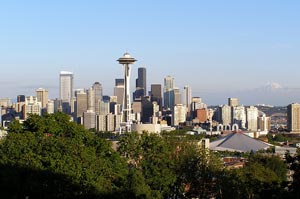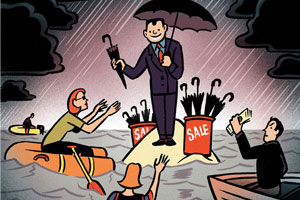
Flickr/<a href="http://www.flickr.com/photos/dph1110/472778842/sizes/z/in/photostream/" target="_blank">dherrera_96</a>
Editor’s note: What’s the best way to adapt to our rapidly warming world? That’s the question journalist Mark Hertsgaard asks in his new book, Hot: Living Through the Next Fifty Years on Earth. The following article is the first of a two-part adaptation about how American cities are preparing for global warming. Join Grist‘s live chat with Mark Hertsgaard here at noon PST/3 p.m. EST.
As a father living in the era of global warming, I have my good days and my bad days. The bad days you can probably imagine. Writing this book has taught me more than I’d like to know about our climate dilemma: about how drastically our civilization must change course to avoid catastrophe, how stubbornly some people and institutions resist even minor shifts in direction, and how destabilizing the impacts that are already locked in are likely to be.
But I have good days as well, and these are usually inspired by stories that show that the climate fight is not hopeless after all. One of my best days came in June of 2008, when I went to Seattle to interview Ron Sims. As the chief executive of King County, Sims was the top elected official of a municipality that encompasses the city of Seattle, some of its suburbs, and the corporate headquarters of Microsoft, Amazon, Starbucks, and Boeing. Over the past 15 years, Sims had pioneered a fresh, farsighted, effective response to climate change that local governments across the United States and around the world were beginning to copy. He had linked his climate policy to a larger agenda of advancing social justice and pro-business economic development. And he had done this while remaining strikingly popular with voters, winning three straight elections by comfortable margins.
What most set Sims apart was the two-track climate strategy he employed. “We absolutely need to reduce greenhouse gas emissions, but we also have to adapt to the impacts we can no longer prevent,” he told me outside his office in downtown Seattle. “The scientists say our region will see warmer, wetter winters in the future. The snowpack [atop the Cascades east of King County] will shrink. That means there won’t be enough water for everyone if we don’t get going on adaptation.”
Although Sims’ ecological commitment was ardent enough to earn him the nickname “Mr. Salmon,” his argument for taking early action to prepare for climate change was based on tough-minded economics. “We think people and businesses will want to move to King County in the future because we took action to prepare for the world of 2050,” he said. “We’re taking steps to make sure we’ll have enough water, we’ll have levees that don’t break, we’ll have alternative energy sources, economic growth in the right places, a green work force. There are going to be winners and losers under climate change. I don’t want King County to be a loser.”
One of Sims’ ideas was to make climate change central to the mission of every department in county government. “Ron is always telling us, ‘Ask the climate question,'” said Jim Lopez, Sims’ deputy chief of staff. “That means: Check the science, determine what conditions we’ll face in 2050, then work backwards to figure out what we need to do now to prepare for those conditions.”
“A levee breach here would cost $46 million a day”
The stories told by the native peoples of the Pacific Northwest often bear an uncanny resemblance to the tale of Noah’s ark. As in the Bible, the native stories include one or more morally upstanding people who, joined by children (but not animals), are loaded into a gigantic canoe to ride out the storm while bad people are left to perish.
That so many such stories exist suggests that flooding was a recurrent aspect of ancient life in the Pacific Northwest. Then as now, storms blew inland from the ocean and traveled east until they collided with the Cascade Range, where they dumped precipitation in the form of rain or snow. Modern science tells us that higher temperatures will cause more precipitation to fall as rain rather than snow and also cause more of the snowpack to melt. As a result, more water will flow down the mountains, increasing the likelihood of flooding in the flatlands that stretch westward through King County to the sea.
One day, I went with Mark Isaacson, the director of King County’s Water and Land Resources Division, to a commercial neighborhood along the Green River, a zone of low buildings separated by half-empty parking lots. It was hard to believe this was some of the most economically valuable real estate in King County. But a levee breach here, Isaacson said, would cost the local economy $46 million a day.
“Many of these buildings are warehouses that supply food and other critical goods to Seattle,” he explained. “Restaurants receive 1,200 deliveries a day. Starbucks has a big distribution facility here, quite a few medical supply companies, too. If a levee broke, the roads here would be underwater, and all those deliveries would stop.” The levees protected 65,000 jobs that generated $3.7 billion of income a year, Isaacson added.
Farmers had built levees along the Green River 50 to 60 years ago, said Isaacson, but those levees were little more than mounds of earth extending along the riverbanks. They were sufficient to protect farmland that could afford to flood occasionally, but inadequate when billions of dollars of commerce were at risk. Like all the departments in King County government, Isaacson’s had been told by Sims to ask the climate question. Once they did, Isaacson said, “My colleagues and I knew right away that we had to upgrade our levees. The problem is, that gets really expensive. Our budget was nowhere near big enough. The only way I could see it happening was with a tax increase, but I was very reluctant to suggest that.”
But when Isaacson outlined the problem, Sims didn’t flinch. “Ron told me, ‘We have to do it. But we have to explain to people why their taxes have to go up, why it’s in their interest that these improvements get made.’ And that’s pretty much what happened. My staff outlined a program of levee improvements and calculated that the cost would average $40 per household in the Green River valley region. Then we reached out to mayors of towns in the valley and to the public. We had open meetings where we explained the situation. People didn’t grumble much. Even towns not located right next to the river agreed to pay, because they understood that their economic well-being would suffer if the levees broke.”
The tax increase, approved by the voters in 2007, increased Isaacson’s budget tenfold. Instead of the $3.4 million per year he had received in the past, the flood control program was allocated $335 million over the next 10 years—monies to be used for repairing some 500 levees and revetments in the county’s flood defense system.
“I can’t put my head in the sand”
If the ancient tales of the Pacific Northwest are any guide, preparing against floods may be the easy part. Native peoples appear to have passed down not a single story concerning drought. But then the Pacific Northwest is famous for its frequent rains, at least west of the Cascades. The future will be different.
There will be much less water available as climate change intensifies, and as Sims saw it, the task of government was to prepare people and institutions to live with less water. “People didn’t want to believe there were going to be water shortages,” he recalled. “After all, this is a place where it always rains. But I said, ‘This is what the science says. We have to respect it.’ The reason we have so many ecological problems today is because we didn’t listen to science.”
In the American West, the traditional response to water shortages has been to go out and find—or steal—more of it. But the shrinkage of the snowpack makes that unlikely. In theory, reservoirs could be built to capture the snowmelt before it flows downstream and disappears into the Pacific. But most of the region’s river basins already contain all the reservoirs they can accommodate.
Sims proposed a set of initiatives that respected ecological realities but upset bureaucratic tradition and popular sensibilities. Rather than seeking to increase the gross supply of water, he fought to maximize the net supply. He did so both by using forestland as a natural reservoir and, most controversially, by reusing wastewater before it was released to the sea. The latter idea provoked a fierce political battle that eventually had to be settled by the state legislature.
The morning we met, Sims took me to the site of one of the toughest fights in that battle, the Brightwater wastewater facility. The idea behind recycled water is simple: Instead of using pure water for all human purposes, why not substitute recycled water for watering golf courses, irrigating landscapes, and supplying factories? The Brightwater facility would take in wastewater, run it through filters to remove contaminants, then pump it out for delivery to non-household customers. In effect, using reclaimed water would allow the county to use the same volume of water twice.
That sounded unobjectionable except for the yuck factor: The reclaimed water had previously been used to wash people’s dishes, fill their bathtubs, and flush their toilets. Sims said most people, however, got past this problem: “We explained that reclaimed water would be carefully filtered and never used for drinking, bathing, or irrigating crops.” The real objections, he continued, as we drove east from Seattle, were economic. “The golf courses don’t mind reclaimed water,” he said. “The pushback came from water agencies that had been selling the golf courses water. One of the [agency] people asked me, ‘Do you know how much money we make from golf courses?’ It’s money! We have to get past the question of who’s making money on things and do what’s right for the community as a whole.”
Water agencies resisted Sims, accusing him of a power grab aimed at stealing their business. The former mayor of Seattle, Paul Schell, charged that Sims’ proposal would raise the price and lower the quality of water in the city. The state legislature eventually joined the fray, blocking the plan for three years. But in the end, Sims triumphed. What was his secret?
“I just didn’t back down,” he replied. “King County had the right of approval over the water planning process and we exercised that right. And we had the science on our side, which was crucial. I told water agencies, ‘We’re going to have less water in the future. You may not like it, but that’s a fact.’ As an elected official, if I know what’s coming, I can’t put my head in the sand and wish it weren’t true. I have to listen and act.”
The Brightwater plant is located 20 miles from Seattle on 114 acres of wooded land in neighboring Snohomish County. The site used to house an auto junkyard, but the wrecks had been cleared away as part of a program to protect nearby Little Bear Creek and add forty acres of hiking trails. After bouncing up a rocky driveway, our vehicle stopped above a huge construction site. Below us, bulldozers snorted exhaust while workers in hardhats hoisted rebar. “This plant relies on an advanced membrane bioreactor treatment technology, the most ecologically friendly filtration system in the world,” said Gunnar Goerlitz, the project manager. “When it opens in 2011, it will be the largest plant of this type in the world, capable of treating 36 million gallons of sewage a day.”
Of the 36 million gallons treated, 15 million will receive only secondary-level treatment and be pumped through a tunnel into Puget Sound. The remaining 21 million gallons will receive additional treatment from the bioreactors, which separate solids and bacteria from water molecules, and be distributed to end users. Some of the water will go to a golf course near Microsoft’s campus in Redmond, but most will be added to the Sammamish River, boosting the flow of agricultural water in the area.
Gunnar confirmed that the Brightwater plant had encountered strong opposition: “When the planning of this facility began in 1999, lots of people didn’t like the idea of including purple pipe [the color used for reclaimed water]. When we got to the design stage in 2002, we asked whether we should put in purple pipe. Ron said, ‘You bet.’ It cost $26 million, but it would have cost much, much more if we had to come back later and retrofit it, because you’d have to dig up all the tunnels again.”
Looking down on the construction site, Sims smiled with undisguised satisfaction. “When people in the year 2050 look at this plant, they’ll say, ‘Those old-timers did this right,'” he said. “Every other water treatment plant is going to have to be retrofitted. Not this one. We did this one right.”
This piece was produced by the Climate Desk collaboration.















